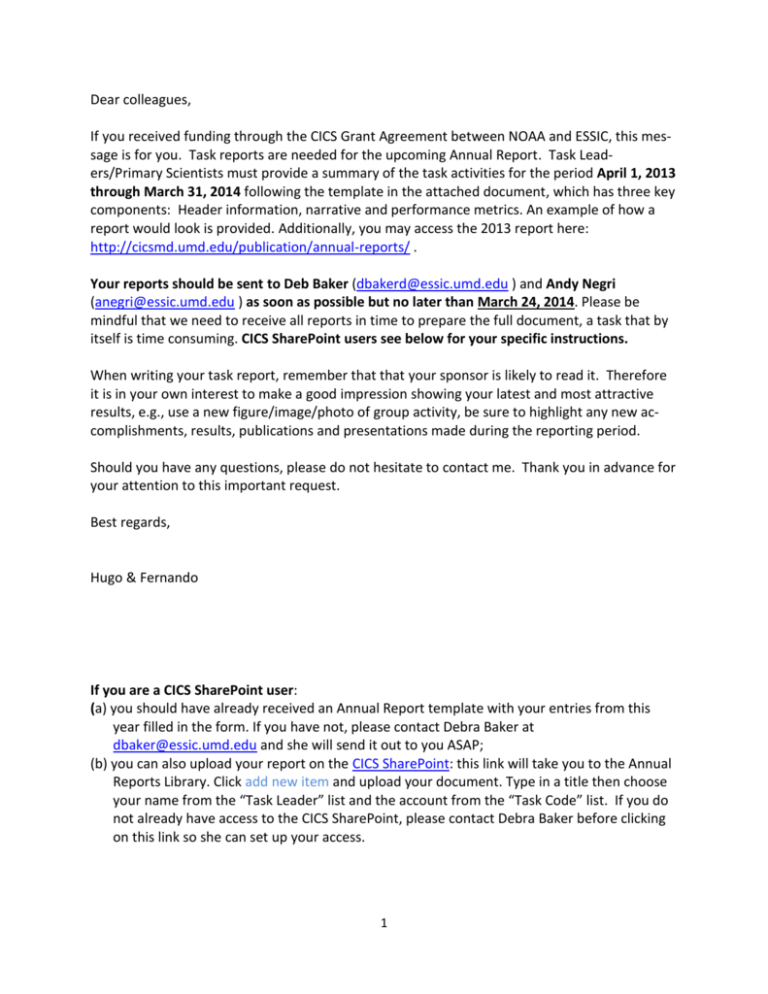Instructions - CICS-MD
advertisement

Dear colleagues, If you received funding through the CICS Grant Agreement between NOAA and ESSIC, this message is for you. Task reports are needed for the upcoming Annual Report. Task Leaders/Primary Scientists must provide a summary of the task activities for the period April 1, 2013 through March 31, 2014 following the template in the attached document, which has three key components: Header information, narrative and performance metrics. An example of how a report would look is provided. Additionally, you may access the 2013 report here: http://cicsmd.umd.edu/publication/annual-reports/ . Your reports should be sent to Deb Baker (dbakerd@essic.umd.edu ) and Andy Negri (anegri@essic.umd.edu ) as soon as possible but no later than March 24, 2014. Please be mindful that we need to receive all reports in time to prepare the full document, a task that by itself is time consuming. CICS SharePoint users see below for your specific instructions. When writing your task report, remember that that your sponsor is likely to read it. Therefore it is in your own interest to make a good impression showing your latest and most attractive results, e.g., use a new figure/image/photo of group activity, be sure to highlight any new accomplishments, results, publications and presentations made during the reporting period. Should you have any questions, please do not hesitate to contact me. Thank you in advance for your attention to this important request. Best regards, Hugo & Fernando If you are a CICS SharePoint user: (a) you should have already received an Annual Report template with your entries from this year filled in the form. If you have not, please contact Debra Baker at dbaker@essic.umd.edu and she will send it out to you ASAP; (b) you can also upload your report on the CICS SharePoint: this link will take you to the Annual Reports Library. Click add new item and upload your document. Type in a title then choose your name from the “Task Leader” list and the account from the “Task Code” list. If you do not already have access to the CICS SharePoint, please contact Debra Baker before clicking on this link so she can set up your access. 1 1. TEMPLATE Task Leader Development of a 4-km Snow Depth Product for the Version 3 Interactive Multi-Sensor Snow and Ice System (IMS-V3) Cezar Kongoli Task Code NOAA Sponsor NOAA Office CKCK_IMSS_12 Tom Schott NESDIS/OSD/SGSP/SEID Percent contribution to CICS Research Themes (1-3) See section 2a, e.g.: Theme 1: 70%; Theme 2: 30%; Theme Main CICS Research Topic See section 2b Estimated percent contribution to NOAA goals See section 2c, e.g.: Goal 1: 0%; Goal 2: 25%; Goal 3: 25%; A two-sentence highlight of your research for the Executive Summary Up to 30 words Background 250-300 words Accomplishments 500-700 words; up to two figures with figure caption Planned work bullets; up to 250 words Publications Separate peer reviewed from non-peer reviewed –only for period covered in report Deliverables e.g., documented instrument development, algorithm development, numerical model development and data set generation Presentations Please list Body Header Task Name Other Performance Metrics Table 3: 0%. (estimated) Goal 4: 25%; Goal 5: 25% e.g., awards; outreach; mentoring, advising See section 3 Link to a research web page 2 NOTES: - If your project is finished, we need a report stating so. - If you have a project and you did not work on it during the last year, a justification needs to be provided. - If your project was finished in a previous year and you reported so, you do not need to prepare a new report (but an email letting us know will help). 2. TEMPLATE’S HEADER INFORMATION 2a. CICS MAIN RESEARCH THEMES Theme 1: Climate and Satellite Research and Applications. Theme 1 incorporates the development of new observing systems, or new climate observables from current systems. Theme 2: Climate and Satellite Observations and Monitoring. Theme 2 is focused on: (a) Development and improvement of climate observables from current systems, and (b) development of all continental and global fields of climate parameters that can be used for climate analysis and climate model initialization. Theme 3: Climate Research and Modeling. Theme 3 is the research component that brings together (a) climate observables, modeling and validation in a comprehensive integrated whole, and (b) observational products with model development efforts to enable research into the improvement of forecasts of climate system variability on space scales ranging from regional to global, and time scales from a week or two to centuries. 2b. CICS SPECIFIC RESEARCH TOPICS The following research topics were identified during preparation for the past CICS Midterm Review A. B. C. D. a. b. E. F. G. H. I. J. K. Data Fusion and Algorithm Development Calibration and Validation Surface Observing Networks Future Satellite Programs Scientific support for the GOES-R Mission Scientific support for the JPSS Mission Climate Research, Data Assimilation and Modeling Climate Data and Information Records and Scientific Data Stewardship Land and Hydrology Earth System Monitoring from Satellites National Climate Assessments National Climate Model Portal Climate Literacy, Education, Outreach, and Engagement 3 2c. NOAA GOALS The NOAA Next Generation Strategic Plan identifies long-term Goals are in four areas that are complemented by three supporting Enterprise efforts: Science and Technology; Engagement; and Organization and Administration. (see http://www.ppi.noaa.gov/ngsp/ for more details) 1. 2. 3. 4. 5. 3. Climate Adaptation and Mitigation Weather-Ready Nation Healthy Oceans Resilient Coastal Communities and Economies Enterprise activities PERFORMANCE METRICS Please fill and include in the body of your report. Performance Metrics FY13 # of new or improved products developed following NOAA guidance 1 # of products or techniques transitioned from research to ops following NOAA guidance 0 # of new or improved products developed without NOAA guidance # of products or techniques transitioned from research to ops without NOAA guidance # of peer reviewed papers 2 # of non-peered reviewed papers 1 # of invited presentations 4 # of graduate students supported by a CICS task N/A # of graduate students formally advised 2 # of undergraduate students mentored during the year 1 4 4. EXAMPLE OF REPORT (not real; just shows how a report would look like) Development of a 4-km Snow Depth Product for the Version 3 Interactive Multi-Sensor Snow and Ice System (IMS-V3) Task Leader Task Code NOAA Sponsor NOAA Office Contribution to CICS Themes (%) Main CICS Research Topic Contribution to NOAA Goals (%) Cezar Kongoli CKCK_IMSS_12 Tom Schott NESDIS/OSD/SGSP/SEID Theme 1: 70%; Theme 2: 30%; Theme 3: 0%. Data Fusion and Algorithm Development Goal 1: 0%; Goal 2: 25%; Goal 3: 25%; Goal 4: 25%; Goal 5: 25% Highlight: We have developed a new 4-km global snow depth analysis and integrated it into NOAA’s Interactive Multi Sensor Snow and Ice Mapping System (IMS). As part of the IMS, this new analysis is ingested into NWP by NCEP to improve the GFS land surface initialization. BACKGROUND This report summarizes the year-2 work of the ongoing NOAA project entitled “Interac-tive Multi-Sensor Snow and Ice Mapping System (IMS) Version 3 – Snow depth”. A new snow depth analysis has been developed and is being integrated into the daily 4-km IMS. The algorithm framework is an optimal interpolation scheme that blends in-situ and satellite-derived snow depth taking into account the geospatial structure of the data and their relative errors. The final snow depth output Figure 1. Snow Depth processing system and data flow. 5 also blends snow depth updates made by the analyst interactively. This is a new product being integrated into IMS, and the first-of-its kind to be developed at NOAA. Figure 1 presents high-level de-sign and data flow of the snow depth processing system. Below are the accomplishments during the second year of the project, followed by future plans for third year. ACCOMPLISHMENTS The automated algorithm and the software system have been developed. Figure 2 presents an example of the algorithm generating blended snow depth output over the Northern Hemisphere using synoptic snow depth reports and snow depth derived from the NASA’s AMSR-E Snow Water Equivalent product. Figure 2: An example of IMS analysis snow depth. The left map shows previous-day analysis on January 1, 2010. The right map shows analysis snow depth on January 2, 2010. The analysis update on January 2 blends the NASA AMSR-E Snow Water Equivalent with in-situ snow depth obtained from synoptic reports. All project deliverables (documentation and software) and milestones have been accomplished as planned. Currently, the software system is being tested and preparations are under way for the Test Readiness Review (TRR). PLANNED WORK Continue work to assess the performance of the algorithm Continue work to refine the algorithm parameters and to improve its performance over highelevation areas Integrate algorithm within IMS Version 3 platform Transition algorithm to operations PUBLICATIONS Green J., C. Kongoli, A. Prakash, M. Sturm, C. Duguay, and S. Li, 2012: Quantifying the relationships between lake fraction, snow water equivalent and snow depth, and microwave brightness temperatures in an arctic tundra landscape, Remote Sens. Environ., 127, 329–340, http://doi.org/10.1016/j.rse.2012.09.008. DELIVERABLES 6 Automated algorithm for a new 4-km global snow depth analysis; Software system for a new 4-km global snow depth analysis; and Documentation for automated algorithm and software system. PRESENTATIONS Kongoli C., and T. Smith, 2013: Blended Analysis for Snow Depth Using Optimal Interpolation, abstract submitted to Spatial Statistics Conference, 4-7 June, 2013, Columbus, Ohio. Helfrich S., and C. Kongoli, 2013: Snow and ice analysis products (poster), Global Cryospheric Watch Workshop, Toronto, Canada (28-30 Jan.) Helfrich S., M. Li, C. Kongoli. 2012: The next generation of the Interactive Multisensor Snow and Ice Mapping System (IMS), Eastern Snow Conference, Huntsville, Ontario (5-7 Jun.) Helfrich S., and C. Kongoli 2012: Improved monitoring of snow depth combining surface observations from existing stations and newly developed acoustic sensors, International Symposium on Cryosphere and Climate Change (ISCCC), Manali, India, (2-4 April). OTHER (e.g., awards; outreach… PERFORMANCE METRICS FY13 # of new or improved products developed following NOAA guidance 1 # of products or techniques transitioned from research to ops following NOAA guidance 0 # of new or improved products developed without NOAA guidance # of products or techniques transitioned from research to ops without NOAA guidance # of peer reviewed papers 2 # of non-peered reviewed papers 1 # of invited presentations 4 # of graduate students supported by a CICS task N/A # of graduate students formally advised 2 # of undergraduate students mentored during the year 1 PERFORMANCE METRICS EXPLANATION This year, we developed a new 4-km global snow depth analysis product (1). Its development involved moving our prior snow research to operations (1). One journal paper on the microwave retrieval of snow depth related to the project has been published (1), while another journal publication on the algorithm is under preparation. Three presentations summarizing the algorithm have been made (3), and another one has been submitted. 7







